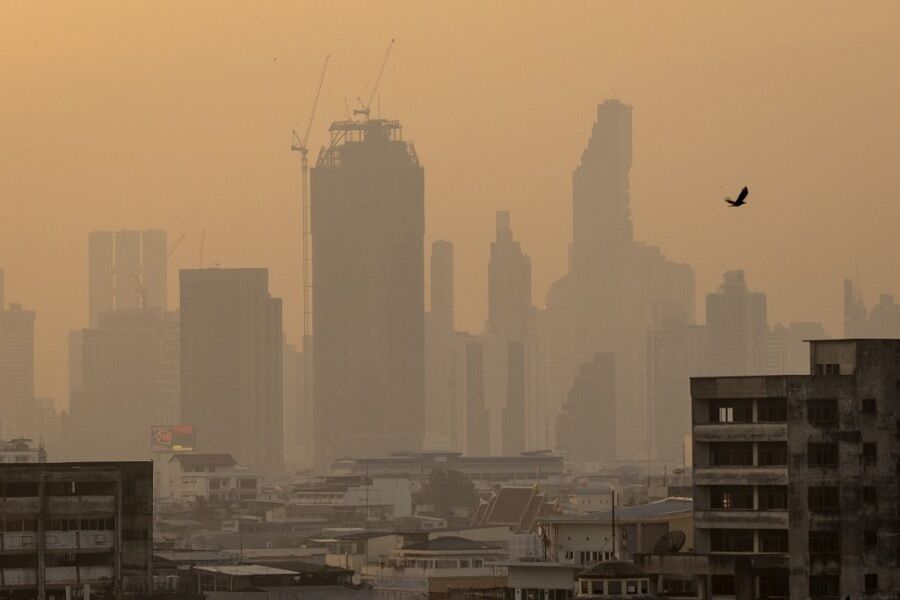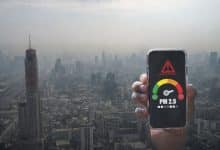Bangkok battles severe PM2.5 pollution, health warnings issued

Bangkok and several provinces across Thailand are currently grappling with dangerously high levels of PM2.5 particulate matter, exceeding standard pollution values and posing a significant health risk. Bangkok’s Phra Khanong district recorded the highest levels, urging the public to wear masks outdoors at all times for protection.
The situation monitored hourly, is a collaborative effort involving the Ministry of Higher Education, Science, Research and Innovation (MHESRI), the Geo-Informatics and Space Technology Development Agency (GISTDA), the National Research Council, the Pollution Control Department, Kasetsart University, and Chiang Mai University.
Data from satellite imagery and applications has revealed that 20 provinces are experiencing orange-level air quality, indicating a detrimental impact on health. Notable examples include Phetchaburi with 74.2 micrograms, Ratchaburi with 71.2 micrograms, and Samut Songkhram with 70.6 micrograms of PM2.5.
In Bangkok, 46 districts are affected by poor air quality, with Phra Khanong at 56.5 micrograms, Bang Na at 52.9 micrograms, and Klong Toey at 49.4 micrograms of PM2.5. Some areas are at a yellow level, indicating moderate health effects, including Lak Si, Bang Kapi, Bang Sue, and Wang Thonglang.
According to GISTDA, as of yesterday, 197 hotspots were detected nationwide, predominantly in agricultural areas, state-owned enterprise zones, national parks, communities, and conservation forests. Provinces with the most hotspots include Sa Kaeo, Chaiyaphum, and Prachinburi. Neighbouring countries also report significant hotspots, with Cambodia leading at 1,788, followed by Myanmar, Vietnam, and Laos.
The Check Dust application forecasts that air quality will remain at unhealthy levels in several areas over the next three hours. The app leverages satellite technology and artificial intelligence (AI) to analyze hourly PM2.5 values across Thailand. This information, combined with data from the Meteorological Department of Thailand and sources of dust, such as hotspots, is presented in an accessible format for users.
Pollution control department
The overall PM2.5 levels exceed standard values in numerous provinces, including Pathum Thani, Bangkok, Nonthaburi, Nakhon Pathom, Samut Sakhon, Samut Prakan, Lampang, Lamphun, Tak, Nakhon Sawan, Uthai Thani, Chai Nat, Sing Buri, Lopburi, Saraburi, Ang Thong, Suphanburi, Ayutthaya, Kanchanaburi, Ratchaburi, Samut Songkhram, Phetchaburi, Prachuap Khiri Khan, Prachinburi, Sa Kaeo, Chachoengsao, Chon Buri, Rayong, and Trat. The northern region exceeds standard values in five areas, while the central and western regions are mostly above standard.
The eastern region also surpasses standard values, whereas the southern region generally maintains good air quality. Bangkok and surrounding areas, measured by the Pollution Control Department in cooperation with the Bangkok Metropolitan Administration, predominantly exceed standard values.
Public health advisories recommend that the general population stay vigilant about their health, reduce outdoor activities, and use protective equipment.
Special care groups should limit outdoor activities and seek medical advice if experiencing health symptoms. Updates on the PM2.5 situation can be tracked via Air4Thai.com, airbkk.com, and the Air4Thai and AirBKK applications.
The seven-day forecast from January 30 to February 5, indicates a downward trend in PM2.5 levels in Bangkok and its vicinities from February 1 to 3. Similarly, a decrease is expected in the 17 northern provinces from January 31 to February 5.
The northeastern region, however, may see an increase from February 1 to 4, 2023, while the Eastern region should see a decrease from February 3 to 5, with the southern region continuously maintaining good air quality, reported KhaoSod.
Latest Thailand News
Follow The Thaiger on Google News:


























